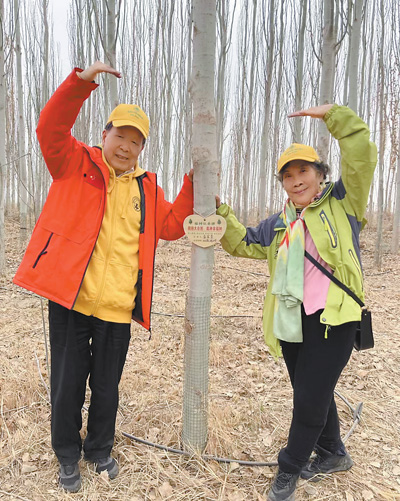Maigaiti county, located in Kashgar Prefecture of northwest China's Xinjiang Uygur Autonomous Region, was previously a part of the Taklimakan Desert, China's largest desert. Today, an ecological barrier stretching 50 kilometers has been established in the area.
Over the last decade, scientists Li Deren and Zhu Yixuan have led an effort to plant trees in the area. With the help of 16 volunteer groups, they have collectively planted over 40,000 trees, contributing to the transformation of the landscape.

Li Deren (left) and Zhu Yixuan pose for a picture in a windbreak and sand fixation forest in Maigaiti county, Kashgar Prefecture, northwest China's Xinjiang Uygur Autonomous Region, in March 2024. (Photo courtesy of the interviewee)
Li, an academician of both the Chinese Academy of Sciences (CAS) and the Chinese Academy of Engineering (CAE), also holds a professorship at Wuhan University. His wife, Zhu, is also a professor at Wuhan University. Both Li and Zhu are 85 years old.
After graduating from university, Zhu was assigned a position at the 7th topographic survey team of the former National Administration of Surveying, Mapping, and Geoinformation in northwest China's Shaanxi Province. The team's primary responsibilities included aerial photography and mapping in northwest China. Zhu was deeply struck by the vast expanse of the Gobi Desert and the arid climate during her time there.
Since 2012, Maigaiti county has been mobilizing over 100,000 individuals to participate in desert tree planting activities during the spring and autumn seasons. In September 2014, Li and Zhu were invited to a forum in Maigaiti where they were informed by a county official that nearly 20,000 mu (1,333.33 hectares) of land had been afforested in just two years. Impressed by this initiative, they joined Maigaiti county's tree planting campaign.
In March 2015, the first group of volunteers arrived in Maigaiti to plant trees. This group consisted of 15 individuals, including Li and Zhu, their colleagues, and schoolmates, many of whom were over 70 years old. On the first day of their project, they planted 96 saplings. Over the course of 10 days, with the help of local residents, they continued their efforts and planted a total of 735 trees in the desert.
As time passed, the initiative attracted a growing number of participants from diverse backgrounds. The couple's schoolmates, colleagues, friends, students, and even their students' students, as well as professors, engineers, returned overseas Chinese, military personnel, doctors, workers, and entrepreneurs, all joined the cause.
Zhu explained that all expenses, including round-trip airfare, accommodation during the tree-planting period, tools, seedlings, and agricultural supplies required for tree-planting, as well as transportation between the work site and accommodation facilities located tens of kilometers apart, were self-funded.
Many people who were unable to participate in person due to work or health reasons showed their support by making donations of money or goods. Despite such support, the volunteer team still faced a significant challenge in the tree-planting process.
"Maigaiti county has a dry climate, with low vegetation survival rates and slow growth," Li explained. At first, their tree seedlings struggled with low survival rates due to a lack of experience. However, undeterred, the volunteers sought advice from local officials and residents, consulted forestry experts, and honed their tree-planting techniques. Through experimentation, they carefully chose indigenous plants suitable for windbreak and sand fixation.
After a decade of planting and scientific care, the survival rate of tree seedlings from voluntary tree-planting activities now exceeds 90 percent.
On March 22, 2024, Li and Zhu, together with volunteers, returned to the windbreak and sand fixation ecological forest base in Maigaiti county to mark the 10th anniversary of their efforts. Witnessing the growth of the trees planted a decade ago into towering forests filled them with joy.
"Over the past 10 years, volunteers from various areas across the country have supported and promoted tree-planting in Maigaiti, inspiring the local community," said Ai Jiangchun, director of the general office of the forestry and grassland bureau of Maigaiti county.
Through collective dedication, Maigaiti has planted 466,000 mu of ecological and economic forests, with a survival rate of over 95 percent for all seedlings.
"Nowadays, satellite remote sensing images provide valuable insights into the status of afforestation, aiding in the precise monitoring and management of forested areas," explained Li.
Additionally, Li guided students in creating historical satellite remote sensing maps of Maigaiti county. These maps offer a clear view of changes in afforestation areas, the growth status of forests, and more, serving as a valuable reference for tree planting efforts across the county.









